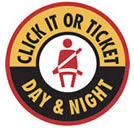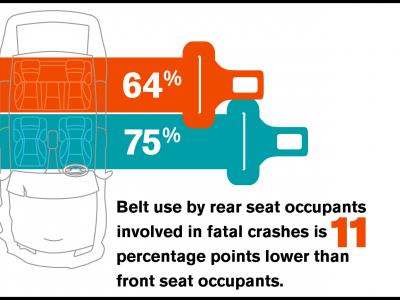Seat belts are the oldest form of occupant protection, with Volvo patenting the first rudimentary seat belt in 1889. However, it wasn't until 1968 that the federal government required seat belts to be installed in all new passenger cars.
U.S. seat belt use rates have steadily increased over time. In 1994, the observed national seat belt use rate was 58%. Belt use reached 91.9% in 2023. Yet despite these gains, too many drivers and passengers are choosing not to buckle up and are paying for it with their lives. Of the 25,420 passenger vehicle occupants killed in 2022, 11,302 (44%) were unrestrained at the time of the crash (Occupant Protection in Passenger Vehicles, National Highway Traffic Safety Administration [NHTSA]).
GHSA PolicyClick here to view GHSA's Policy and Priorities on Occupant Protection. |
Click It or Ticket
 "Click It or Ticket" is a national program operated by NHTSA to boost seat belt use and reduce highway fatalities through increased, high visibility enforcement of seat belt laws, coupled with national and state media campaigns utilizing earned, paid and social media. It takes place each year around Memorial Day. Recent campaigns have focused on nighttime seat belt use because fewer people buckle up at night.
"Click It or Ticket" is a national program operated by NHTSA to boost seat belt use and reduce highway fatalities through increased, high visibility enforcement of seat belt laws, coupled with national and state media campaigns utilizing earned, paid and social media. It takes place each year around Memorial Day. Recent campaigns have focused on nighttime seat belt use because fewer people buckle up at night.
"Click It or Ticket" is one of the most successful efforts to improve behavior on a mass scale in the history of public outreach and education campaigns. The program’s irrefutable success in vastly increasing seat belt use is a model example of how equitable enforcement of traffic laws and public awareness of safe driving practices can help save lives. Two decades of demonstrations projects have shown that "Click It or Ticket" and high visibility enforcement campaigns for special populations of drivers with low seat belt use rates are effective at increasing belt use, with most special programs resulting in 2- to 14-percentage point increases in observed front seat belt use during daytime hours (High-Visibility Enforcement and Seat Belt Use, NHTSA).
GHSA's State Highway Safety Office (SHSO) members provide funding for increased enforcement and work with law enforcement agencies and other partners to educate drivers and their passengers about the importance of seat belt use.
News tagged with Seat Belts
Related News
Featured Initiative
Safe Youth Mobility Grant Results: Montana
In Montana, Native Americans comprise 6.2% of the population but account for approximately 17% of the state’s motor vehicle crash deaths each year. A closer look at the data reveal that Native American drivers 20 years of age and younger are involved in 30% of these fatal crashes. To tackle this issue, the Montana Department of Transportation (MDT) developed the "Safe On All Roads" (SOAR) traffic safety program, which is managed by coordinators living in Tribal communities.
Read More



